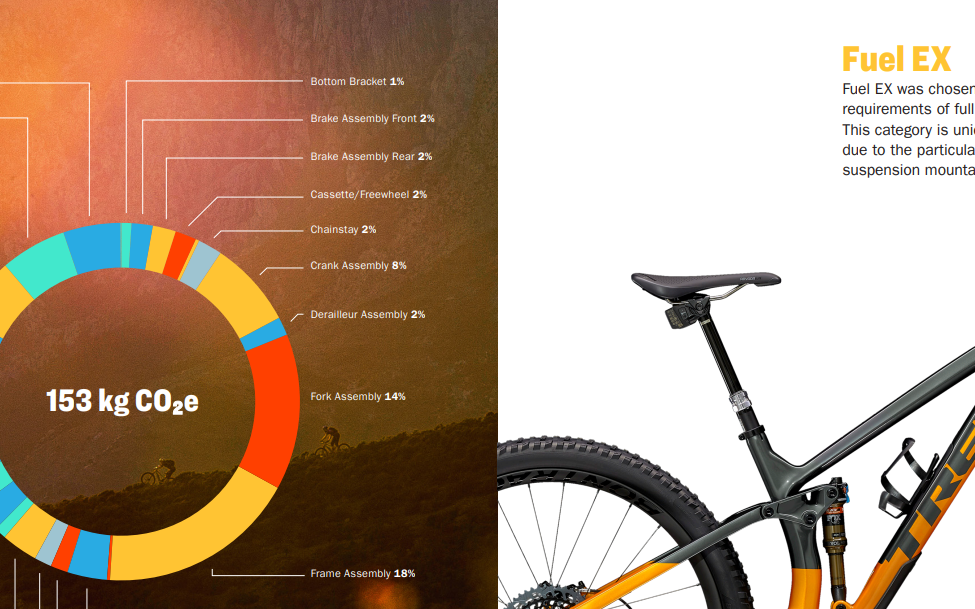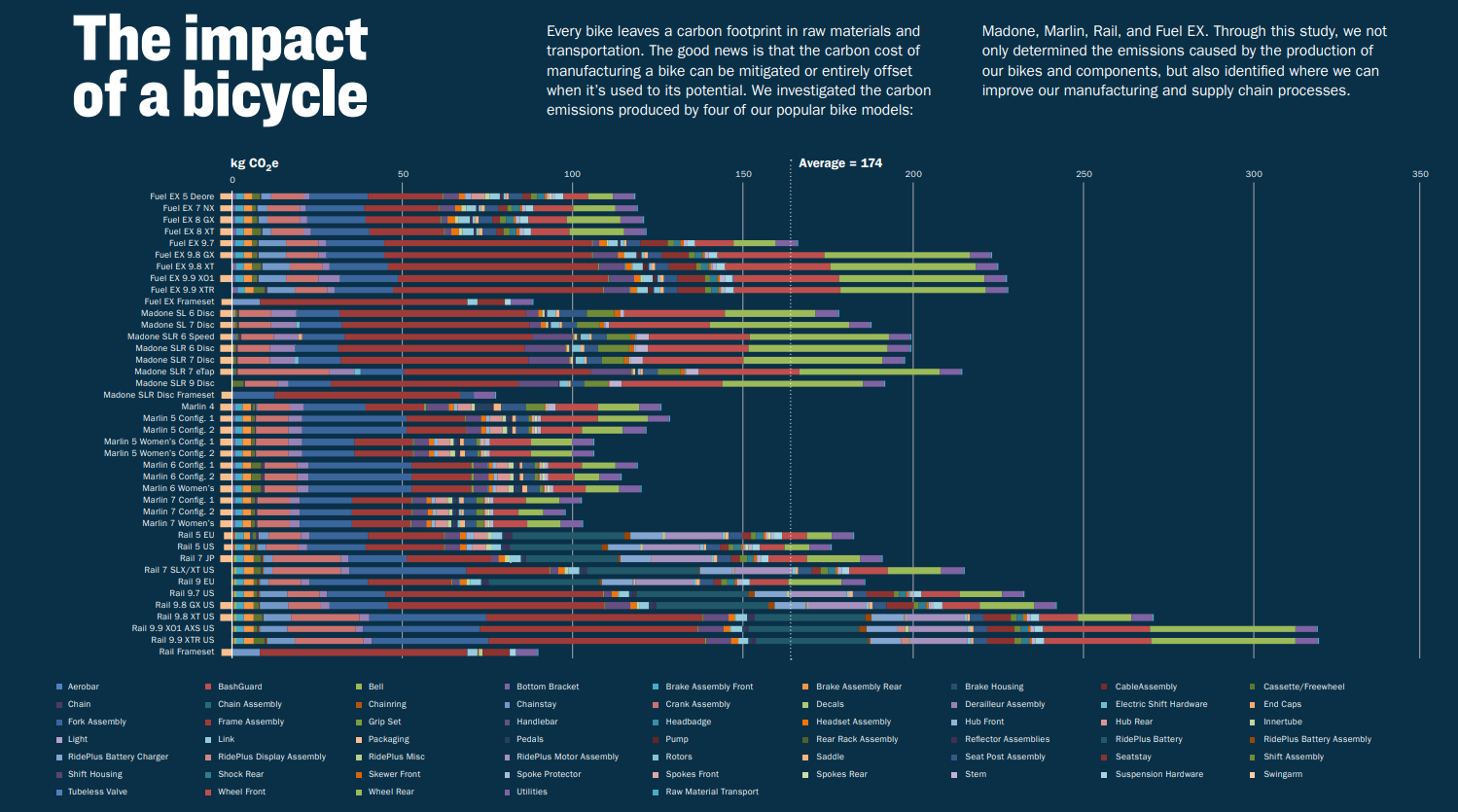
Uncle Dave
Lessons from the Trek Sustainability Report
Hands up if one of the consequences of the pandemic is that you’re convinced that we may only have one-to-two years of normalcy left before we’re forced to take to the ocean in rafts to escape the forest fires, anti-vaxxers and/or organ thieves? No? That’s just me? Well, maybe you’ve found that you’re eating more takeout, buying more online and throwing more things out? Perhaps that’s a more universal sort of experience?
A brief aside. We’ve been bombarded by stories that recycling isn’t worth it. Recycling in BC is actually really great! “It will just end up in the landfill anyway” is not a valid excuse for not recycling.
The pandemic has changed the way we deal with waste and the sort of things we throw out. Limiting transmissibility created new waste streams and increased others (masks and wipes were hardly a thing before hand, and single use items have gone up), as well as leading to a general increase in waste (more people working from home, more income directed towards goods vs. activities). The data suggests that this trend is real, and any reductions to fuel use and emissions seem to have been a short term trend.
This is fascinatingly ironic. In Canada, we’ve reached a point where in our most recent election, for the first time ever, all major political parties accepted climate change as real, and had at least some token items within their platform to address it. Public opinion supports the fact that global warming is a serious thing that needs to be dealt with, but our actions don’t. We continue to burn more fuel than we ever have. We continue to generate more and more waste. How can we be more concerned about our environment, but more likely to be doing activities that cause it harm?
Bicycling itself seems to get a free pass on most of this. Being an environmentally sound form of transportation can do that. But consider that most of the bikes that we own and ride do absolutely nothing to offset our carbon intensive lifestyles. Commuting to work on a bicycle is a great way to reduce your carbon footprint. Driving to the trailhead to ride around in circles in the forest does the opposite. That’s not to suggest that we should all stop mountain biking and entertain ourselves by constructing sculptures out of found materials rescued from the landfill. I’m just pointing out that mountain biking, and mountain biking purchases (or any leisure activity, really), deserve some scrutiny. Any carbon generated is an extra, no matter how green you make it.
The question is though, how much carbon does the manufacture of a bicycle create? Are there large differences depending on material? What parts contribute the most? What sort of things should manufacturers and consumers be concerned about? In all honesty, I know very little about these things, and I’m probably further over on the “cares about this kind of shit” side of the spectrum than most. But how in the hell can we even begin to have these conversations when we don’t really know what we’re talking about?
Thankfully, Trek has started the conversation that will help us understand these things a little bit better, with the release of their Sustainability Report. Not surprisingly, the release of this report grabbed less attention than any of their product launches. Or any product launch, for that matter. One can only get so excited about 39 pages full of infographics, I guess. But this is kind of a big deal! They say that you can only create meaningful change to those things that you are able to measure. This report is a pretty great starting point for understanding what goes into manufacturing a bicycle.
Of course, it’s not perfect. I’m left with as many questions as anwers. Most importantly, where do Trek’s calculations start and where do they stop? How far down the supply chain have they gone? I would love some more detail on what is included and how these numbers were calculated.
But still, I feel much smarter after reading this report than I did before. I did some quick Google searches and, as far as I can tell, no other bike company has put anything out that is this comprehensive. Just by putting this document out there Trek has announced that this is something they care about, and all of these numbers are there for us to keep them honest. As well, this gives some added context to their moves on bicycle packaging and ocean plastic. The existence of this report and the need to update it at a later date would be enough to drive most people towards action. So all sorts of kudos to Trek, and hopefully some other companies are able to also put their money where their mouths are. That saying doesn’t really translate all that well from the singular, does it?
Here are my key takeaways from the report.
Lesson #1 – This is small potatoes. Sort of.
If you’re already bored, the most important piece of information that you can pull from this report would be this:
“If you ride about 430 miles you would have otherwise driven, you’ve saved the carbon equivalent of what it took to make your bike.”
Note that it doesn’t say “if you drive to the trailhead and ride your bike for 430 miles” or “if you ride 430 miles of lift assisted trails”. This is a fairly small number if you compare it to your car, but unless you’re also using your mountain bike to commute to work, it’s all just extra carbon you’re creating when you buy a new mountain bike. But, there’s an easy solution here! Do 430 miles of commuting to work on your mountain bike and call that sucker carbon neutral!
Lesson #2 – Infographics are hard!
In my professional life I often need to create charts to sell people on a complicated idea, so I know the pain of creating a meaningful, impactful and accurate chart. But my goodness Trek! What the hell is this thing? How are we supposed to interpret this thing when there are so many similar colours! With some close scrutiny, you can figure it out. But get out a stopwatch and time yourself on how long it takes to find data on a particular “fork assembly” on this chart.

Lesson #3 – Holy carbon fibre!
While I hate the infographic, I love the information. Within that hard-to-read-chart there is a lot to learn. Trek provides us with the detailed carbon footprint for several bicycles that are supposed to work as proxies for their entire line (page 5). The closest for us is probably the Fuel, so that’s where we will keep our focus.
The first obvious point is that there’s a really large gap between the footprint of the lower tier models (9.7 and below) and the upper tier models (9.8 and above). For the upper tier stuff, there’s a huge jump and it primarily comes from the frame and the wheels. What gives?
Well, carbon fiber is what gives. The lower tier models are all aluminum and the upper tier are all carbon. This is the first really tangible look that I’ve seen at the possible impacts of an aluminum bike vs. a carbon bike. Where does this come from though? From the raw material? From the energy required to process? From the farts of all of that labour required to lay each frame up?
The gap between aluminum and carbon wheels is just as vast. There’s a huge jump when the spec goes to carbon wheels, to the point where a carbon fiber front wheel has a bigger hit than an aluminum bike frame.
Lastly, suspension forks don’t seem to add much to the footprint of a bike. It’s the 3rd largest contributor on most bikes (after the frame and the wheels), but there’s not much of an increase between the suspension fork of the Fuel and the (I assume carbon) forks on the Madone. I would have thought that all those small parts would come at a higher carbon price. As well, there isn’t much of a difference between the aluminum and full suspension Fuel and the aluminum hardtail Marlin.
How much are we really talking, though? The high end carbon fiber Fuel 9.9 has a ~ 225 kg of CO2e footprint (about the same as burning 100L of fuel) versus the ~125 kg of the Fuel 8. Again, see point #1 for the relative scale, but there’s a pretty good argument here that aluminum bikes are better for the environment.
Lesson #4 - If only we could manufacture locally
Page 4 has some interesting takeaways. First, it is noble that Trek includes a carbon calculation for employee’s commutes to work. This is a pretty easy number to externalize and well done for taking ownership of this number.
Next, the actual production of bicycles dwarfs their other numbers, but transportation and distribution is next on the list. It would be interesting to have them include this within their bicycle specific breakdowns as, unless you live in Taiwan, it’s pretty hard to buy a finished bicycle if you skip this step. Assigning the transportation hit to each bicycle would be a better way to understand the true impact. It’s also interesting that the solution for this put forward by Trek is “use less air freight” and “consolidate shipments. It’s interesting to see that “move our manufacturing closer to market” isn’t presented as a realistic solution. If transportation carbon was included directly against each bicycle, perhaps this would have more appeal?
Lesson #5 – Those ebikes don’t come cheap
Comparing the Rail 9.9 to the Fuel 9.9 gives us a pretty good idea as to how much extra carbon is produced when you add a motor and a battery to a bicycle. Unfortunately, it doesn’t come cheap, especially if it’s coupled with a lot of carbon fiber. The 225 kg of CO2e produced by the Fuel leaps up to around 320 kg of CO2e for a similarly equipped rail. That’s a pretty big jump, especially on a percentage basis. But at the same time, you don’t need to offset very much shuttling or chairlift rides before you’re carbon neutral.
Lesson #6 – We think we’re important, but we’re really not
This has nothing to do with carbon footprint but I thought it was interesting, nonetheless. Trek was kind enough to break out the carbon hit for their benchmark models, and then a lump sum of carbon for all of the rest of their bikes combined. The scale of the graph on page 4 is totally crazy (it jumps from 0 to 21,500…and then to 25,000…and then to 37,5000…so each gridline represents 21,500, 4,500 and then 12,500 tons of carbon? okay). By my estimate (which is a shot in the dark with that graph, if I’m being honest):
Fuel EX – 7,000 metric tons of CO2e (153 kg CO2e per bicycle on average)
Madone – 2,000 metric tons of CO2e (197 kg CO2e per bicycle on average)
Marlin – 35,000 metric tons of CO2e (116 kg CO2e per bicycle on average)
Allowing for a large margin of error for the crazy graph scales, one could take the total carbon hit for each model and divide through by the average carbon per bicycle to create some broad estimates on how many bicycles Trek is manufacturing each year. If my guesses are anywhere close to accurate, it looks like Trek sold 46,000 Fuel EX’s, 10,000 Madones and 300,000 Marlins! Some hardtail that I didn’t even know existed outsells the Fuel EX 6 to 1?
Going a bit further, the remainder of their line was ~ 200,000 metric tons of CO2e (at an average of 174 kg of CO2e per bike), or 1.15 Million Bicycles! I’m going to assume the Fuel outsells the Slash, Remedy and Session by a fair margin, which suggests that the full suspension mountain bike market isn’t how Trek butters their bread.
In Conclusion
Most of the report talks about how Trek will save the world by encouraging more people to ride bicycles. This is a fair goal! A bicycle is a far less carbon intensive means of transportation than an automobile, with emissions that are little more than farts and sweat. Pushing more people to bicycles would help us to dig out of our global warming hole.
If your focus is mountain bikes, this becomes a more complicated question. Throw in longevity and reparability and you could really do yourself in trying to figure out the most carbon friendly bicycle. I like that we finally have some numbers to think about and my key takeaway is that I should put more effort into riding my bicycle to work and to the trailhead.











Comments
Cooper Quinn
2 years, 2 months ago
Ride to your ride, whenever possible.
Ride to work, whenever you can.
Ride to get groceries and run errands, whenever you can.
Ride to the pub.
Reply
Cr4w
2 years, 2 months ago
Amnesty for assault charges due to commuters beating up bike thieves.
Reply
Dan
2 years, 2 months ago
Indeed.
I know you’re not over-simplifying this immense problem… and also know precious few people - cyclists and otherwise - have the means and the capacity to design their lives with sustainability at the forefront of their thoughts and actions. It’s just not how our cities and towns have taken shape since Model Ts started rolling off assembly lines.
For me, I made a series of conscious decisions five years ago to leave the big city (Seattle) and move to a smaller town (Bellingham). While a primary driver was the employment opportunity offered to me, at the micro level when it came to choosing a neighborhood where I could 1) afford to live 2) avoid an unreasonable or unpleasant commute and 3) have ready access to trails… I feel I was EXTREMELY lucky to be able to satisfy each of these goals. I *can’t* reasonably pedal to work (unfortunately) but these days I often work from home anyhow. I *can* basically coast to the trails and when i do drive, I am behind the wheel of a thirty year old Bubble Era Toyota van.
I can’t deny I have had ebike fever for a few months now but sh*t, reading this report gives me pause. After getting past the high entry cost, can I justify the decision given what I now know about the environmental impact? Will I really reduce car trips if I purchase a mountain-specific ebike? (FWIW I have had my eye on the *alloy* Rail for a while. I don’t really see the benefit of a carbon frame for a bike with a motor.)
Reply
Vik Banerjee
2 years, 2 months ago
Capitalism is the worst system ever except for all the alternatives. Given none of the world's capitalist economies is truly running without Government intervention we can setup a regulatory structure that incentivizes companies to meet whatever targets/goals we want them to. The problem is we don't do that. We talk about protecting the environment and then we rearrange the deck chairs on the Titanic.
What should be happening is the full lifecycle cost of a product should be charged to the customer and used to pay for the product and all its impacts. Then that $10K e-bike that's obsolete in under 5 years would be more like $15-$20K and riding steel/AL hardtails would seem like an even bigger bargain. Currently we let some folks shit the bed and make everyone take the stinky sheets to the laundromat and pay to try and wash the brown out. That doesn't put much incentive on companies making the products or people buying them to reduce their impacts.
Reply
Karl Fitzpatrick
2 years, 2 months ago
Rearranging deck chairs. Never heard that one. Brutal and succinct yet apt af
Reply
Bikes
2 years, 2 months ago
I'd say its the only human system, with all variations including the one western/modern man knows regulated to some degree via currency requirements or outright regulation/taxation.
Second paragraph, true cost pricing seems a valid scheme, but its hard to set for the topic at hand. There is no "true cost" to certain environmental impacts, CO2 especially. They are currently estimated based on very different assumptions as we have no idea what the financial impact will actually be. If you want to regulate CO2, just tax it (or cap and trade, but that sets up issue by itself). Everyone along the consumer chain will pay it, and the end product will be priced accordingly.
Reply
Rick M
2 years, 2 months ago
We can't define the while lifecycle. As mentioned in previous posts, identifying all the factors (impacts, effects) in making a product isn't feasible. Think of all the correlated and/or interdependent factors in Trek's example report. Expecting the consumer to offset all the lifecycle costs is even more infeasible. How each consumer uses the product is up to them. So, in your defense, do we assume an upper bound, worst case of all the known factors? Seems unrealistic...but then again, so is Trek's report. Their report is interesting and groundbreaking, but it's not motivating.
Reply
bushtrucker
2 years, 3 months ago
The biggest problem isn’t the carbon footprint of the bikes, it’s knowing how much they’re being ridden before being thrown away. Bikes are a relatively low impact item but we live in such an “upgrade” obsessed society that perfectly good ones just get left to die.
Also, if you focus solely on carbon footprint then you are kinda missing the point anyway. Things are far more complex and interconnected than just raw outputs of CO2.
The best thing (and only really sustainable thing) we can do as a society is consume less. That includes material goods such as bikes but also things such as driving, flying and animal products.
I do think the point you end on cycling habits is a great one. It actually made me reflect on my own journey into bikes. I’m an adult cyclist and have ridden about 10,000km a year for the past decade. I fell in love with biking as a student commuter and that had extended to touring and now trail riding (I ride to the trail exclusively taking up to 2hrs at times incl. some train travel). I’ve lived car (and flight) free for the past 3 years.
Anyway I counted back and I’ve owned 8 bikes over my adult life.
Cheap Alu Beater (First bike, sold after 18 months, gotta start somewhere I guess)
90’s Steel Roadie (fast and terrifying, quickly realised “road” riding wasn’t for me, sold)
Surly LHT (over 30,000km, rebuilt at least 4 times, most k’s I’ve put on any bike, now my Dad’s)
Aside front that first bike which I bought with literally no idea, they’re all steel and still being ridden. And I can see all of them being ridden for another decade at least. Makes me wonder if Trek is selling any “sustainable” bikes at all.
Reply
fartymarty
2 years, 3 months ago
Surlys just keep going... I've got a Krampus that I bought used 7 years ago and have no plans on selling it. It still gets ridden as much as my steel FS bike (which I also don't plan on selling).
Reply
Vik Banerjee
2 years, 2 months ago
My SS Krampus is definitely one of my forever bikes. I might need a derailleur in my elder years!
Reply
Karl Fitzpatrick
2 years, 3 months ago
It makes you wonder that, despite the relatively low carbon footprint of producing even ebikes, if Trek wanted to make a point of being seen as caring about the CO² produced by their manufacturing and transportation, they wouldn't just lean on the outstanding sales they get from the likes of the Marlin and other beginner/intermediate models.
Oh wait, I forgot to factor in capitalism.
Until capturing market share and making as much money as possible for your share holders takes a back seat to the environment, studies and reports like these just seem like lip service.
Also I agree with your pov regarding not being clear enough with what the beginning and end point of the CO² produced is. Mining and refining the raw minerals? Just to produce it in the factory(ies)? Life of the bike (including recharges, parts replacement etc)? Maintenance (eg. Lubricants)? Disposing of the worn parts/batteries? What do they consider is the average usable life span of any of the bikes used as the examples?
BTW this is coming from someone who loves a nice shiny thing but thankfully gets to use their lack of money as a way of appearing frugal and highly attuned to their environmental impact... *shrugs shoulders*.
SS hardtail FTW!
Reply
fartymarty
2 years, 3 months ago
Capitalism and the Environment are not compatible.
Reply
Cr4w
2 years, 2 months ago
Capitalism and the environment could be compatible if externalities were properly factored into the price of goods. Externalities such as poor wages and corporate welfare and the cost to the environment. Things like meat would cost a lot more and people would consume them more sparingly. The system can work if we want it to.
Reply
JVP
2 years, 2 months ago
The alternatives to capitalism don't appear to be all that great. I guess unless a good chunk of the world is kept in poverty, but I don't think that is what anyone is suggesting. This is a human nature problem more than a capitalism problem.
Not to say that the western capitalist model doesn't need improvement, it certainly does. An obvious step would be putting a price on carbon that factors in it's impacts. Not some complicated cap and trade scheme that is easily gamed, but a simple and consistent tax.
Reply
Morgan Heater
2 years, 2 months ago
Simple and consistent taxes have a tendency to be very regressive.
Reply
Karl Fitzpatrick
2 years, 2 months ago
Is a complex one but I think human nature is tied up in capitalisms excellent advertising strategies.
If 'they' didn't tell us we needed it, 'we' wouldn't be any wiser...
Reply
Tobius
2 years, 2 months ago
Capitalism or consumerism? There is a difference and they shouldnt be conflated. We are in a time of heavy convenient consumerism. We are in love with cheap because we think cheap is smarter than expensive. We think if we pay a carbon tax we can offset our consuming of cheap items produced en masse so everyone can also enjoy cheap. Clearly this isnt working for many reasons. A cheap item imported by a company with no interest in our local environment except your dollars is not inexpensive. Look at the life of any product and use that as motovation when buying. Think how needed is it and what happens to it after its lifecycle. If it isnt clear, dont buy it. If you chose to after truely thinking it thru, perhaps its not capitalism but ones own consumerism that is the problem. As a manufacturer, I am aware of this with each and everything I buy and I rarely compromise with cheap.
Reply
Spacelizard
2 years, 2 months ago
Infinite growth>finite planet
Reply
Sean Chee
2 years, 3 months ago
A company like trek is lucky as they will have a dozen or so major suppliers to who they account for a significant amount of revenue. Their ability to impact the practices of those upstream suppliers is great.
I work for an aerospace engineering firm and sustainability of our composites manufacturing is a key focus of our environmental impact policy. We are a small fry in the global (and often highly specialised) composites market, so that creates some challenges for us. If our volume was larger we would be able to impact the behaviour of upstream suppliers. We have to get prepreg shipped in freezer containers from Asia. Even if we had the equipment to make our own, we would still be relying on the same upstream fibre and resin suppliers, and transporting it to site would only have a marginally lower emissions than present. I think we’re close to carbon neutral atm.
Recycling our epoxy tooling has been one of the toughest challenges, bike makers are more likely to be using billet tooling at least.
More challenging has been water use neutrality. Its been almost as expensive to implement but for less relative benefit. Electronics and electrical propulsion (my areas of expertise) has a huge water footprint. We do our best to offset our use but if the water is being used on a large scale in Taiwan, Europe or the USA, how much of a benefit is offsetting that use in Australia? I only raise this point as the guts of what I use are the same as e bikes. Semiconductors, batteries, brushless motors. A single MCU of which an ebike will have six or seven at a guess (my systems can use over 100!) can take 40-300L of water to manufacture, depending on the manufacturing processes involved. That’s just one of hundreds of semiconductors that will be inside an ebike system.
Ultimately upstream suppliers in both composites and electronics have little incentive to place principles ahead of profitability because margins are tiny, and competition fierce. Pressure from consumer electronics, aircraft and automotive manufacturers has been having some positive impact, but they are still very cost sensitive markets so it’s nowhere near as large as it should be.
Reply
boomforeal
2 years, 2 months ago
a few thoughts:
Reply
Simon Apostol
2 years, 2 months ago
As someone in conservation/ecological restoration, I find this report interesting, and thanks for diving into it. There is some tension and debate in the climate activist community about whether focusing on individual consumer choices (I.e., buying a carbon bicycle) is a way to deflect responsibility from governments and corporations whose actions are the primary drivers of climate change. However, some studies have shown that there is a positive feedback loop where attempting to live more sustainably can motivate people to support policies that have a larger impact. Cycling for transportation is a great example. If you never ride or walk to work you might never notice how unsafe, dirty, and wasteful that 5 lane arterial you need to cross is. Or maybe you can fight for trail access close to your home. Ultimately we all need to do more individually AND wrk towards the dismantling of industries that are the biggest drivers of global warming, while building new and better alternatives. Our new world can be better, but we have a lot of work to do.
Reply
Kyle Doherty
2 years, 2 months ago
It would be nice if the carbon costs were printed on product labels and there were some government agency certifying that the parent corporation met the minimum effort to achieve accuracy in those estimates. If this existed it would definitely impact my consumer choices.
Reply
Tehllama42
2 years, 2 months ago
I do agree - but carbon alone is a somewhat poor metric in terms of overall effect - quite a few products are carbon negative, but big methane, or others are major offenders in terms of water vapour output (but still get to sell carbon credits).
Reply
Greg Bly
2 years, 2 months ago
It's a luxury. All first world luxury is temporary satisfaction with long term complications. It's our love of cars and trucks. Vehicles that weigh tonnes to haul Bodies that weigh in kilos.
Then we commute long distances for that desired job.
Well I don't. I ride a ten year old mountain bike with the goal of a sustainable bike . It's not difficult.
Each automobile running on fossil fuel releases litteraly tonnes of Co2 . Each year. How much from a carbon fiber bike?
I refuse work that involves long commutes.
It's out unbelievably wasteful lifestyles that destroy our own environment.
Yes I'm a part of that greedy consumer lifestyle. More material shite than I know what to do with . That material shite is what we are brainwashed to believe will give us happiness.
Sort of ironic me looking at new stuff on this site. It's refreshing to know that this site has Andrew . A man that lives a practical life and often the discussion is about sustainable parts and the joy of riding.
In conclusion you , I , we are the problem . Pointing fingers at something else is easy and a great way to stay ignorant and not change.
Reply
Morgan Heater
2 years, 2 months ago
The over-all system that relies on fossil fuels is the problem. Entrenched industries that actively fight to undermine the political will to change are the problem. Governments that don't make the necessary investments in carbon neutrality are the problem.
Reply
Znarf
2 years, 2 months ago
Great discussion with lots of interesting and substantial viewpoints and remarkably civil for a topic which touches climate change. That's why I love nsmb.com and the user base on here! Thank you all very much!
Reply
fartymarty
2 years, 3 months ago
"Throw in longevity and reparability and you could really do yourself in trying to figure out the most carbon friendly bicycle" - in my mind this is where metal (steel and aluminimu) bikes make the biggest difference. Especially if you have your geo sorted and aren't looking to upgrade every few years to keep up wiht the latest fads.
I'd bet in 10 years time there wont be many 2021 carbon bikes on the trails as 2021 metal bikes.
It is good to see Trek put this out. At least it is a start and other manufacturers can follow and at least start the discussion about the carbon impact of bike.
As an side on climate change the following graph is interesting - https://www.ucsusa.org/resources/each-countrys-share-co2-emissions (despite being a few years old). If we reduce all carbon emission here in the UK there is only a saving of 1% to be had. Everyone needs to buy into it for it to work, consume less / make / buy products that last and can be repaired rather than disposable.
Reply
Znarf
2 years, 3 months ago
That’s right.
At the same time, every kg of greenhouse gas that isn’t emitted helps. Even if we fail the 1.5deg goal (which ist pretty likely), the more greenhouse gases in the atmosphere, the more drastic the changes will be and probably also faster.
There’s a margin between somewhat livable and apocalyptic which isn’t 0/1.
Please do what you can, even if other people don’t. It DOES make a difference. Even if it is only perceivable on a personal scale. It will be scientifically measurable without doubt with 8 billion people.
Regarding cycling and emissions. On one hand, spending calories for fun isn’t efficient.
But if you stick to riding to the trails instead of driving all the time, use your fitness for commuting and replace your bikes/equipment only when it fails, there are many worse ways of recreation in the developed countries.
And I’d wager people who spend time on trails (or even maintain trails) will develop a certain sense for nature and keeping it intact.
Cool article, central topic and good of Trek to be (comparably) forward with this data. Sustainability and repairability should be a fixed, important criteria for all reviews on nsmb.com!
Reply
Skooks
2 years, 2 months ago
"I'd bet in 10 years time there wont be many 2021 carbon bikes on the trails as 2021 metal bikes."
You are probably right, but in my experience, carbon fiber frames are both easier to break and easier to repair than aluminum frames.
Also left out of this discussion is the issue of recycling. An aluminum frame is easily and cheaply recycled. Carbon fiber not so much. This brings down the CO2 cost of aluminum even further relative to carbon. Wether people *do* recycle their aluminum frames is another issue worth discussing.
Reply
IslandLife
2 years, 2 months ago
A little off topic but related... this article brought up some questions for me about ebikes and their batteries.
What's the current lifespan on an ebike battery pack? Are they like cellphones and laptops where you've got a pretty finite number of cycles and then they're done within a few years? How many is it? Or are they like the better EV's out with there where with large charging and depletement margins, very good thermal management and active software management, degradation is low and packs last a long time?
If you ride a couple times a week, what does you battery look like 5 years from now? And how does that affect re-sale? Is re-sale just not an option for a second owner or a longtime owner without replacing the battery pack first? How much are replacement packs? Do ebikes tell you their current state life? For instance my iphone tells me that the battery is at 86% of the capacity compared to when it was new (3 years old).
Reply
Vik Banerjee
2 years, 2 months ago
I think the real problem with e-bikes is that when any part of the electronics/power system fails it will be a boat anchor unless you can get spare parts. How long will Trek or Spesh stock a control board or display or battery for a 2021 e-bike?
If e-bikes systems were generic like other bike components you could at least get a replacement aftermarket, but if they are manufacturer/model specific you are at the mercy of the manufacturer to stock parts and sell them to you.
I suspect this will make selling a used e-bike a challenge and the effective service life quite short. Then the question is how much of that e-bike gets recycled into something useful and how much ends in the landfill.
Reply
Cr4w
2 years, 2 months ago
I know three people who bought late model e-bike mountain bikes in the last two years and those bikes are now out of commission indefinitely due to unavailability of parts. They might be good machines for noobs but a strong rider can grind those little motors' internals to dust.
Reply
earle.b
2 years, 2 months ago
There is a guy in the UK doing a pretty good job of trying to keep / get those motors running.
https://www.performancelinebearings.com/
I recall him getting skids of motors from Brose to cannibalize for parts as Specalized / Brose don't make the individual parts available and offer little to no service outside of warranty.
Reply
Perry Schebel
2 years, 2 months ago
good to see. i imagine there'll be opportunity for a thriving cottage industry of savvy fixers able to repair no longer supported ebike hardware. curious to see the state of all the current 5 figure ebikes in 10 years time.
Reply
Vik Banerjee
2 years, 2 months ago
Maybe. It will depend on what it costs to buy new and what it costs to repair. As soon as repairs reach a significant % of new most people will buy new to get the latest greatest tech.
If repairs can be done affordably and if they are reliable there will certainly be a market for them...at least as long as the rest of the e-bike holds up in terms of MTB standards compatibility.
Timer
2 years, 2 months ago
Aren't E bike systems generic for the most part?
Except for some custom Specialized stuff most seem to be running of-the-shelf systems from Bosch, Yamaha, Shimano or Brose.
Reply
Morgan Heater
2 years, 2 months ago
I think this is partly because the market is still very immature.
Reply
Sean Chee
2 years, 2 months ago
So it depends on how the charge cycles are managed. I don’t have that information but I do work extensively with the cells used inside the packs. Best case scenario, you’re getting 2000+ cycles out of a cell before its capacity starts degrading significantly. Worst case is about 100 cycles.
I expect real world behaviour to be closer to worst than best. In weight sensitive applications, you don’t want to be carrying around unused capacity. I think capacity would start to noticeably reduce after around 200 cycles. But without knowing how the bms handle the packs, these are just educated guesses. Of course there are many factors that can impact battery life.
Reply
Sanesh Iyer
2 years, 2 months ago
Awesome, all my bikes are negative carbon!
Im really glad Trek put out this report. I've been doing a little LCA recently and it's an immense amount of work. It really takes committment.
The report is far from perfect, it would have been great if it was done to iso 14001 and the system boundaries discussed. This type of work is utterly meaningless without system boundaries (except for comparative effects). My only source of confidence here is that the numbers are largely similar to those released by Specialized and Duke university, so the methods must be similar.
I would have liked them to evaluate more parameters other than CO2.
One other thing is durability. From my experience the number one killer of longevity is bearing bores. I bought an aluminum frame because I find I can put more bearings into an Alu frame. Besides that, is recyclability. I'd like to see companies create a more circular system. Imagine if you're 7000 series Alu MTb could be recycled into a cheaper casual bike. The dream.
But yeah. Bikes are small. We need to look at the driving involved in the sport too. Ride your bike from home. It's more possible than you think.
Reply
Znarf
2 years, 2 months ago
I like what Santa Cruz is doing here: Putting bearings in the links. If the bores are toast. Swap the link or repair it, not the whole frame.
Reply
benC
2 years, 2 months ago
Thanks a bunch for bringing our attention to this, and kudos to Trek for starting the conversation
FWIW, "...it jumps from 0 to 21,500…and then to 25,000…and then to 37,5000", I'm gonna assume that first number should be 12,500?
Reply
Dave Tolnai
2 years, 2 months ago
Ha ha...well that's of course what they meant! I was never great at those "what is the missing number from this series" puzzles.
If anything, that means even fewer Madones and Fuel EXs.
Reply
cheapondirt
2 years, 2 months ago
I have to drive a lot for work. Let's say 35,000km/year at 14.6L/100km. Burning diesel produces 2.69 kg CO2 per L. That's about 13.75 tonnes of CO2 per year. It's a whole other problem (what do you do, quit the job and let someone else do it?) But unfortunately it jades a guy on emissions numbers. It doesn't feel much like my frame material of choice really matters because it's so relatively minor. Thanks for reminding me that things I can control still matter, even if other things outside my control are bigger.
Reply
Timer
2 years, 2 months ago
I'm assuming those 14.6l/100km of diesel are for a large delivery vehicle or goods transporter? Using that much fuel to carry a single person would sound insane in the age of 4-6l/100km diesel cars.
Reply
cheapondirt
2 years, 2 months ago
Yeah, a big (crew cab long box) one-ton pickup used to haul stone veneer, mortar, scaffolding and tools. It's not bad for what it is.
Reply
wizardB
2 years, 2 months ago
If you fashionistas would ride your bikes until they are completely worn out it would make a huge difference. I know the industry is constantly telling you that you need the latest and greatest, well big news mountain biking is about having fun not pretending to be the next coming. Ride more bitch less and reuse your bikes and parts until they are worn out not just unfashionable.
Reply
tdzride
2 years, 2 months ago
Who knew my carbon frame wasn't as much of a carbon sink as previously thought! great article, definitely supports the rise of the "green economy" (carbon credits and other emissions reductions techniques).
Reply
Dan
2 years, 2 months ago
I understand the Rail is getting updated for ‘22 and seeing that graph I have to wonder if this report has even anything to do with that.
Reply
Vernon Anderson
2 years, 2 months ago
This comment has been removed.
Ceecee
2 years, 2 months ago
Anal. 'It's the little things that count'
Reply
Allen Lloyd
2 years, 2 months ago
As a biker who also spends lots of time doing data analytics, the big chart is garbage. The fix is super easy, group parts together and provide additional charts to show the detail. The top chart should be frame / components. Component should then be grouped, then allow for drill down to the individual parts. Logically that is what people really want to know, so give it to them in the format that answers their questions in the easiest format. It would also allow Trek to show us vs. suppliers and potentially supplier vs. supplier. I mean who wouldn't love to know if Shimano is more environmentally friendly than SRAM?
Reply
Brad Sedola
2 years, 2 months ago
In comparison, how much carbon is emitted to shoot people like Shatner up into space for 10 minutes simply for shits and giggles? Bet its a bit more than what my 2003 TDI Jetta burped out for the 11 and a half years of ownership.
Reply
Znarf
2 years, 2 months ago
I just read a great article about this very question. One launch/flight with the virgin or SpaceX tourism space craft uses/emits about as much kerosene/co2 as one intercontinental flight (New York - Paris or similar) with a big air liner with around 300 passengers.
So that's a lot of emissions to keep some billionaires or millionaires entertained for a couple of minutes. But at the same time if you take into account how many average people / airliners fly every day that's a staggering amount of CO2.
Now, imagine if space tourism would become a Joe Average thing, cheap and affordable, so everyone could do it for fun...
Reply
Timer
2 years, 2 months ago
These kinds of super expensive luxury things don't really matter much for overall CO2 emissions because there are so few of them. Same for Ferraris or other supercars. They use a lot of petrol but they are so exotic and are driven so rarely that it doesn't matter.
Reply
Brad Sedola
2 years, 2 months ago
Ever driven the highway between Vancouver and Whistler?
Reply
Tehllama42
2 years, 2 months ago
Just look at the effect of making one day of concrete across the globe. IF worrying about this starts to feel silly, then that means you have a good grasp of how dB scales work - because these are multiple orders of magnitude smaller in effect.
Making landfill food is still poor design, but the industry basically embraces it nearly as badly as the consumer electronics industry, because as customers, we're dumb.
Reply
rcybak
2 years, 2 months ago
Am I on the wrong forum here? I thought human beings, along with every other animal on the planet exhales carbon dioxide (CO2) during respiration? I struggle to see the connection between breathing and environmental destruction. My problem isn't with CO2 emissions, but with pollution and waste. I'm not sure how carbon emissions have hijacked pollution as the planet's number one problem, but it seems to me that carbon footprints are the least of our worries. Climate change is happening, it has always been happening, and whether or not it's a bad thing seems to be irrelevant to the conversation for some reason. This Trek report comes across as a waste of effort.
Reply
Dave Tolnai
2 years, 2 months ago
It’s like all of the stages of climate change denial in one comment!
1- it’s not real.
2- it might be real but it’s always happened.
3- it might be real, but who knows if humans cause it.
4- okay. Maybe it’s real. Is it really so bad?
You seem to be missing “okay. So it’s real. It’s too big a problem to fix”
CO2e accounts for other atmospheric pollutants other than carbon. And yes, other forms of pollution are bad. That would fall under the ocean plastic portion of the report, for example.
Reply
rcybak
2 years, 2 months ago
I'm not denying anything, but to call CO2 a pollutant is wildly inaccurate. Are you suggesting that exhaling is pollution? Makes literally zero sense.
Reply
mrbrett
2 years, 2 months ago
The amount of something can make it a problem or not a problem.
Reply
Mammal
2 years, 2 months ago
CO2 is a reflector that allows light radiation into our atmosphere, but keeps the Infrared rays bouncing around within, multiplying the heating affect. It also lasts in our atmosphere many times longer before it breaks down, compared to other things that do this. That is why CO2 has been targeted as the single biggest contributor to global warming.
Reply
Cooper Quinn
2 years, 2 months ago
CO2 buildup in the atmosphere contributes to global warming. Other greenhouse gasses include water vapor (which you also exhale), and methane (which comes out the other end). Just because there are also natural causes doesn't mean its not a problem. Apple seeds have cyanide.
Crucially, the CO2 you exhale was already in the current carbon cycle - its from plants and stuff you ate (the C is, anyway), not from sequestered sources like oil, gas, coal, or other fossil fuels. Its also an order of magnitude less than what we're burning - somewhere well south of 10% (and, again, its from a closed loop cycle).
Reply
Please log in to leave a comment.